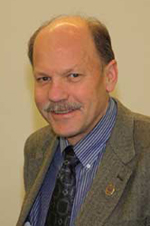May 2012

Nicholas S. Hill, MD
A Look Back
We all know that the years go by quickly, and this past year has been the quickest yet for me. When I started my presidency, I had a number of major goals in mind. I’d now like to cast an eye back to assess my progress. Organizations like the ATS are often compared to ocean liners: they can’t and shouldn’t change direction too nimbly. Even allowing for the excellence and diligence of our staff and the talent and commitment of our membership, finding the time to develop and implement new initiatives is very challenging.
Keeping these considerations in mind, I am pleased with what we’ve been able to achieve. One of my main initiatives was to enhance what the ATS does for patients and their families. I formed the Presidential Commission on Patient Involvement to assist me in framing this initiative. Via a series of teleconference calls and face-to-face meetings with members of the commission and working with the Patient and Family Education Committee, we came up with ideas to enhance online offerings for patients, packaging them better and making them more accessible.
We have also launched the Breathing Better Alliance, a collaboration of ATS and PAR member organizations to advocate for respiratory health issues of mutual concern, focusing initially on increased funding for the NIH. The idea is to have local ATS and PAR members meet face-to-face with key congressional members when they are in their district office. In addition, we continue to work on the possible publication by the ATS—again in collaboration with PAR members—of a lay journal that would enable us to reach out to patients and families. The format would be highly readable and provide education and advice on an array of respiratory, sleep, and critical care–related health issues.
Another goal was to strengthen relationships between the ATS and industry. I aimed to promote the idea that, contrary to what we hear from some politicians and the popular press, the relationship between medicine and industry is vital to innovation and progress in the development of new drugs and devices. These relationships must be managed in a transparent and ethical manner, of course, but PhRMA guidelines and the standards set by the Council on Medical Specialty Societies (CMSS) code on conflict of interest, which the ATS adopted during my presidential year, should help to achieve this. We have formed an Corporate Member Program that enables us to maintain appropriate communications with industry. I have also devoted a presidential message and have co-authored an editorial on this subject in our “Blue Journal” with Drs. Ted Reiss, Joel Moss, Molly Osborne, and past president Randy Curtis. The ATS welcomes participation by industry scientists in our assemblies and symposia, and we want to develop new ways of bringing academic and industry scientists together to enable more research to facilitate drug and device discovery and development.
We also aimed to strengthen ATS relationships with international sister organizations. An overriding concern has been that the global health challenges we face—the increasing use of tobacco products, continuing spread of resistant tuberculosis, and morbid effects of indoor air pollution that afflict large populations—are too great for a single organization to combat. Only by working cooperatively can we speed progress against these scourges. The International Health Committee has been active in this area for some time, and the newly formed Tobacco Control Committee has members working with the World Health Organization. We forged new relationships with the Kyrgyz Thoracic Society and the National Research Institute for Tuberculosis and Lung Diseases in Tehran, and we’ve continued our support of the Forum of International Respiratory Societies (FIRS), through which we are promoting World Spirometry Day to enhance public awareness of lung health.
Space does not allow me to recount the progress we have made in several other important areas, nor to acknowledge the many individuals who have contributed during my presidency year. However, I must recognize two other signal achievements. First is the appointment of John Hansen-Flaschen to assume the editorial reins of the Proceedings of the American Thoracic Society (PATS). Under Dr. Hansen-Flaschen’s leadership, we can expect PATS to evolve into a clinically oriented academic journal that will offer lively editorials and features of interest to practicing clinicians as well as relevant original articles marked by excellence in clinical science. Second, for the first time since I joined the ATS leadership in 2008, we had a favorable operating surplus. It’s a testament to the capable financial leadership of ATS executive director Steve Crane and former chief financial officer Carl Aloi, who left the Society in April to pursue a new opportunity—we sincerely thank Carl for his great contributions. The excess of revenues over expenditures will enable us to devote some additional resources to develop new initiatives to enhance our offerings for members and contribute to our reserves and to increase advocacy efforts on behalf of research.
This past year has been very rewarding. I have thoroughly enjoyed and am very grateful for the experience. I have countless members and staff to thank for their support. This is truly an exceptional organization with many individuals who are totally committed to our values and mission, and they continue to inspire me. Although stepping down will be bittersweet, I can rest assured that I leave the presidency in the even more capable hands of my multitalented successor, Monica Kraft, MD, who will be a truly outstanding leader.

